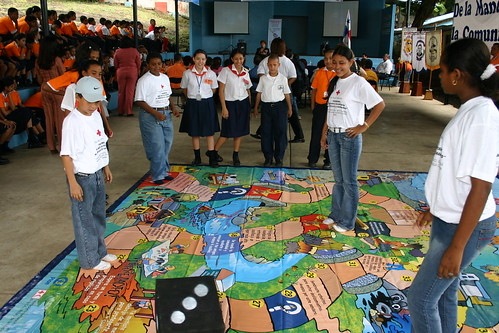THEMATIC SESSION CIVIL SOCIETY PARTICIPATION IN DISASTER RISK REDUCTION
 Photo: Margarita Villalobos / UNISDR |
1. BACKGROUNDDisaster risks related to hazards such as tropical cyclones, flooding, earthquakes, droughts and tsunamis; as well as risks related to technological hazards 1, constitute an important challenge for development. During 2011 only, 302 disasters took 29.782 lives, affected 206 million people and caused damages estimated in 366.000 million dollars. |
_______________________________________________________________________________________________
Whereas developing countries and the most vulnerable people are under a great risk, losses such as the eastern Japan large-scale earthquake and tsunami, show an increase in global social and economic losses due to the increasing magnitude and frequency of disasters. Therefore, the disaster risk reduction (DRR) constitutes one of the major challenges for the region´s sustainable development, and in this context, the reduction of vulnerability and exposure to risk, as well as the increase of resilience, require an integral approach (public and private) for the incorporation of strengthening mechanisms such as public and private investment planning systems on infrastructure and social protection.
The Hyogo Framework for Action 2005-2015 (HFA), the international agreement that guide the governments, communities and private sector to promote a culture of prevention and disaster management in order to minimize the loss of human lives and economic damages due to natural hazards and increase resilience at regional, national and local level; establishes five priorities for action that draw practical directions for all the key actors involved in disaster risk reduction.
2. Civil Society Participation in Disaster Risk Reduction
The considerable reduction of losses due to disasters, in both lives and social, economic and environmental assets of the communities and countries requires a process of awareness, mobilization and cooperation of different key agents, among which the civil society stands out, including the representatives from the private, scientific and academic sectors. Even when it is deemed that the States are mainly responsible for the achievement of the HFA goals, the active participation, specialized opinion and contribution from the civil society are relevant for the generation of conditions and strategic partnerships towards the advancement on the HFA priorities.
Moreover, in this context, the Private Sector Advisory Group (PSAG) created within the frame of the International Strategy for Disaster Reduction of the United Nations (UNUSED) has as fundamental objective, the incorporation of different agents from the private sector at all levels and promote support for the building of resilience conditions. The evident rise of economical and social costs due to the increased magnitude and frequency of disasters at global level, stated in the Global Assessment Report on Disaster Risk Reduction (GAR); reaffirms that it is essential for the private sector to guarantee the continuity of its operations and business as well as its investments during disaster situations. Therefore, investing in human talent and technical and financial resources, and support social actors such as governments in the building of resilience and with the fundamental task of saving lives and livelihoods, is more than a philanthropic and social responsibility action, a highly rentable strategy that converts, and at the same time place these Civil Society sectors as key agents for disaster risk reduction.
3. Session Goal
Identify and promote processes and mechanisms of civil society and its linkages to public policies for DRR. Identify the current situation, barriers and limitations among them and how to promote its actions to favor DRR and humanitarian relief.
4. Session scheme and issued to be addressed
First panel: Civil society Inputs to disaster risk reduction processes
● Civil society (NGO, organizations in general)
● Grassroots organizations
● Volunteering
Second Panel: Private investment on DRR
- Linkage between the private and public sectors with the civil society to achieve a sustainable local development. Practical Experiences and regional progresses, and steps to follow.